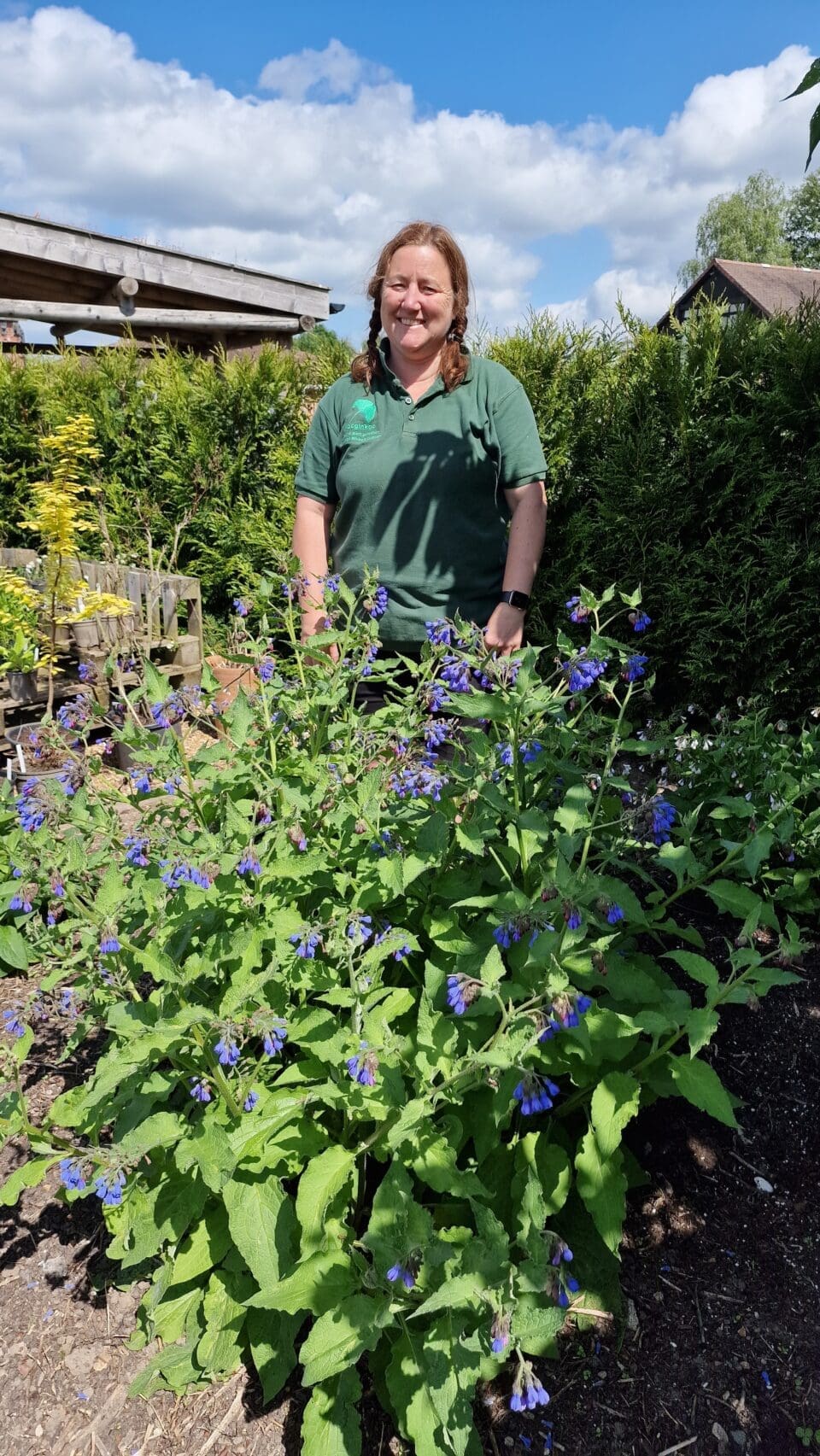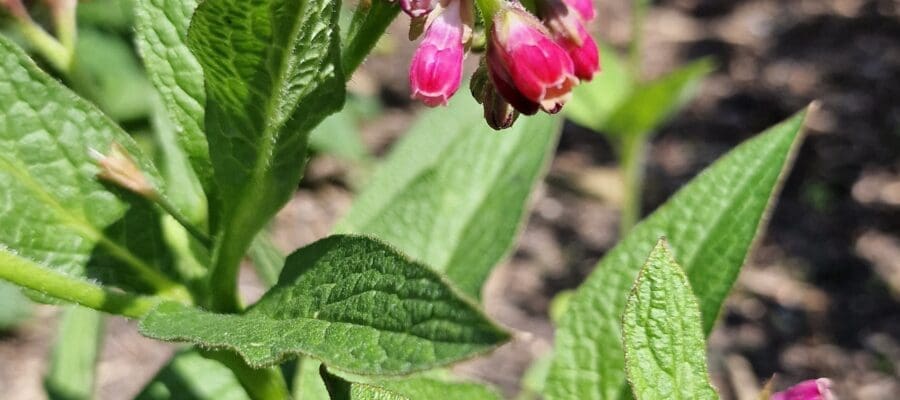The guardianship of the National Plant Collection for Symphytum (comfrey), has been awarded to sustainable growing charity Garden Organic by Plant Heritage.

This is a glowing accolade for the charity’s work documenting, developing and preserving a comprehensive collection at its organic demonstration gardens in Ryton near Coventry. It’s also the location of the Heritage Seed Library, which already has National Plant Collection status.
Horticultural conservation charity Plant Heritage currently oversees 95,000 plants held in more than 700 different National Plant Collections spread across the country. These ‘living libraries’ are a vital resource for plant conservation, and protect and keep many different plant groups alive, ensuring they remain in cultivation. Collection holders range from passionate individuals to botanic gardens, plant nurseries, local authorities and charities.
Emma O’Neill, head gardener at Garden Organic, said: “We’ve worked hard to establish and preserve 29 varieties of comfrey – and are always on the lookout for new varieties of this important plant.
“At Garden Organic, we’re committed to conserving a diverse range of garden plants to protect plant diversity and crucially to boost biodiversity. Our Heritage Seed Library already conserves and protects 800-plus historic heritage varieties.
“We’ve been growing comfrey throughout our 65-year history as our founder Lawrence Hills led experiments using the herb, which showed it was an excellent natural fertiliser. Hills’ experiments took place in the village of Bocking, near Braintree, and many of his trials were named after the village – with Bocking 14 eventually identified as one of the most nutritious varieties of comfrey and least likely to self-seed.”

Comfrey leaves are rich in valuable plant nutrients including nitrogen, phosphorus and potassium, which once steeped in water create a wonderful organic fertiliser. Comfrey fertiliser will boost leaf growth, promote root development and help flowers and fruit to form. Comfrey also produces beautiful flowers that attract bees and hoverflies essential for pollination. It makes a great ground cover, an effective mulch and helps break up tough soil.
Plant Heritage is delighted that Garden Organic is going to conserve the country’s comfrey collection. Gill Groombridge, business manager at Plant Heritage said: “Garden Organic has expertly cared for the Heritage Seed Library – a hugely important resource – for 15 years, so we’re delighted they also now have a comfrey collection too. Without collection holders like Garden Organic, our ongoing plant conservation work wouldn’t be possible.
“Given the ever-changing climate issues we face, it’s vital that new National Plant Collections are accredited, as this ensures that a range of plants remain in cultivation for future generations while benefitting the wider environment.”
By following the advice from Garden Organic’s head gardener below you’ll be able to grow and harvest your own comfrey and make your own liquid plant feed. You’ll never need to purchase expensive plant feed again!
For full instructions on how to make comfrey fertiliser go to //gardenorganic.org.uk/comfrey.
How to grow comfrey
- Choose your site carefully – it needs full sun but will grow in most soil types (except very shallow or chalky). Comfrey can live for 20 or more years, so it’s a great perennial that you don’t need to replace but it is too vigorous to grow in a pot,
- Allow 60-90 cm between plants.
- Once established, it needs very little maintenance, however, to maximise your comfrey crop, extra feeding with manure and compost or grass clippings will all help to produce more leaves.
- Cuttings planted in spring will produce a first leaf harvest before the end of the growing season.
- To maximise leaf growth, remove flowering stems in the first season. This will pay dividends in the second year.

How to make comfrey liquid fertiliser
- Cut off the leaves about 5cms above soil level. Wear gloves, as the stems are covered in stiff hairs that can irritate the skin.
- Fill a bucket or barrel with water and add approximately 1kg of cut or bruised leaves to every 15litres of water. You needn’t be too precise!
- Press the leaves down firmly so they are covered with water and cover the container.
- After four to six weeks a noxious (very) smelly brown liquid is ready for use. There is no need to dilute.
- Strain off the sludge at the bottom and put it on the compost heap.
To make a concentrate, you don’t need water:
You will need:
- Two-litre plastic drinks bottle, without a cap.
- A collecting vessel – large yoghurt pot, ice cream carton or similar.
To make:
- Turn the bottle upside down and cut off the bottom.
- Pack in the cut and bruised comfrey leaves so the bottle is full. Press them down firmly.
- Cover the open end with a polythene bag, held in place with an elastic band, to prevent drying out.
- Stand/fix/wedge the bottle upside down so that it will drip into your collecting vessel.
- As the leaves rot, a brown comfrey liquid will drip out of the bottle into the collecting vessel below.
- Add fresh cut/bruised leaves, pressed down firmly, into the bottle, to keep a constant supply of rotting material
- This concentrate should be watered down according to its strength – when thick and black, dilute one-part feed to 20-parts water; when thin and brown, dilute one-to-10. You needn’t be too precise.
Other ways to use comfrey leaves
- Place cut or bruised comfrey leaves in alternate layers throughout your compost heap. Their decomposition will encourage bacterial action causing the heap to heat up and speed up the composting process.
- Use as a mulch. Chop up comfrey leaves with grass cuttings and place a 5cm layer on the surface of the soil around all plants. This will slowly rot down to provide nutrients and act as a mulch to keep in moisture and help control weeds.
- Add fresh cut leaves to your leafmould heap. Their nutrient-rich liquid will be absorbed, making it a perfect medium for growing seeds and potting compost.
- Fertilise the bottom of your potato and runner bean trenches with a layer of comfrey leaves. As they break down, the plant roots will access the potassium-rich fertiliser.
To find out more about Garden Organic’s conservation work and to become a member and learn more about growing sustainably and organically visit: gardenorganic.org.uk To find out more about Plant
Heritage and its National Plant Collections, visit plantheritage.org.uk





